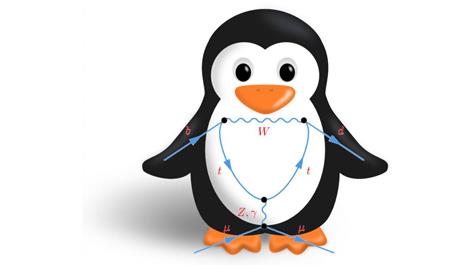‘Penguin decay?’ Think new physics, not rotting birds
A group of physicists has published a set of results that could offer an avenue for the discovery of new physics beyond the Standard Model.
The physicists have published a calculation related to the “penguin decay” process in the journal Physical Review Letters. Christopher Bouchard, a post-doctoral researcher in physics at William & Mary, was one of the researchers involved in the penguin decay project. He was a member of the group who used Fermilab supercomputers to run simulations for the project.
The term “penguin decay,” Bouchard explained, has nothing to do with rotting birds.
“It describes a very rare process. This process doesn’t happen within the Standard Model of particle physics,” he said. “But it can effectively occur from a series of allowed interactions. Each one of these interactions is improbable, and when there’s a string of them, that’s even more improbable. ”
A subatomic particle known as the B meson produced in a high-energy collision will decay, or change into another type of particle. The Standard Model — physicists’ inventory of forces, particles and their interactions — describes many of the ways that different particles can decay.
But every once in a while, the B meson doesn’t follow the Standard Model script. This rare process has been called penguin decay. A press release from the University of Illinois College of Engineering announcing the publication of the results noted that penguin decay occurs in around 20 out of a billion instances of B meson decay.
Bouchard said that penguin decay and other phenomena outside of the Standard Model are exciting for physicists as they indicate possible avenues for new theoretical and experimental investigations.
“If and when we find physics beyond the Standard Model, it won’t disprove the Standard Model,” Bouchard said. “What it means is that we’ll have to add some bells and whistles to a corner of the Standard Model to describe the new stuff.”
And how do penguins come into it? Bouchard said that it involved physicists in a bar and a bet on a game of darts.
“They were in a bar,” Bouchard said. “And there was beer and a game of darts involved. When you sketch the decay, you can arrange the lines and points in such a way that it looks like a penguin, kind of. John Ellis, a renowned British theoretical physicist, said, ‘If I lose this game of darts, I’ll call this a penguin diagram in my next paper.’ And he did. And it stuck.”
















